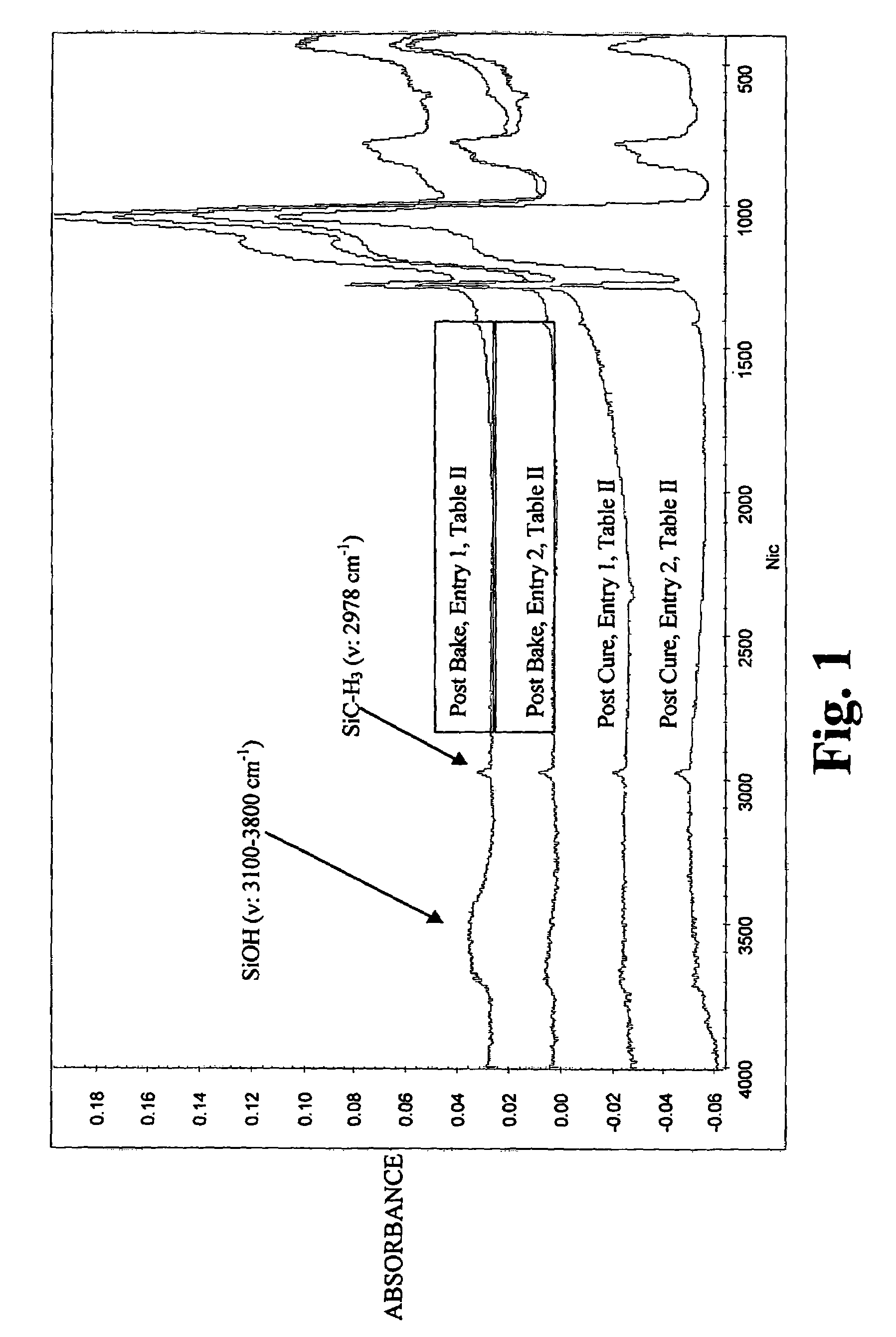Low metal porous silica dielectric for integral circuit applications
a technology of low metal porous silica and integrated circuit, which is applied in the direction of resistive material coating, metallic material coating process, pretreatment surface, etc., can solve the problems of interconnect rc delay, power consumption and signal cross-talk becoming increasingly difficult to solve, and requiring heating for both aging or condensing process
- Summary
- Abstract
- Description
- Claims
- Application Information
AI Technical Summary
Benefits of technology
Problems solved by technology
Method used
Image
Examples
example 1
[0096]This example shows the production of a nanoporous silica with a porogen having a high concentration of sodium. A precursor was prepared by combining, in a 100 ml round bottom flask (containing a magnetic stirring bar), 10 g tetraacetoxysilane, 10 g methyltriacetoxysilane, and 17 g propylene glycol methyl ethyl acetate (PGMEA). These ingredients were combined within an N2-environment (N2 glove bag). The flask was also connected to an N2 environment to prevent environmental moisture from entering the solution (standard temperature and pressure).
[0097]The reaction mixture was heated to 80° C. before 1.5 g of water was added to the flask. After the water addition is complete, the reaction mixture was allowed to cool to ambient before 4.26 g of polyethylene glycol monomethylether (“PEO”; MW550 amu) (with >300 ppb Na) was added as a porogen, and stirring continued for another 2 hrs. Thereafter, the resulting solution was filtered through a 0.2 micron filter to provide the precursor ...
example 3
[0100]Example 2 is repeated except this example adds sodium cation (sodium hydroxide (see entry 3), or sodium sulfate (see entry 4) to restore the low k. Sodium hydroxide (NaOH, 23 ppm) or sodium sulfate (Na2SO4, 40 ppm) was were added to the ion-exchanged PEO and the precursor masterbatch. Films are deposited onto a wafer by spin coating at 2400 rpm or 3500 rpm. After spin coating, the film is heated in three hot plates at temperatures of 80° C., 175° C. and 300° C., one minute each. After bake, the film is cured under flowing nitrogen at 425° C. for one hour. The results of k and R.I. of the post-cure films are listed in the following table.
example 4
[0101]Example 2 is repeated except this example adds tetraorganoammonium (TMAA) (entries 5, 6, and 7), TMAH (entry 8), or TBAA (entry 9)) ion to restore the low k. Various amounts of TMAA were added to the ion-exchanged PEO and the precursor masterbatch. In some cases, small amount of methyltriacetoxysilane (MTAS, 1%, see entry 6) were added to the solution to serve as an in-situ surface modifier to make the surface less hydrophilic. Films were deposited onto a wafer by spin coating at 2400 rpm or 3500 rpm. After spin coating, the film was heated in three hot plates at temperatures of 80° C., 175° C. and 300° C., one minute each. After bake, the film was cured under flowing nitrogen at 425° C. for one hour. For entries 5 and 6, the average pore size diameter was 2.5 nm. The results of k and R.I. of the post-cure films are listed in the following table. It is shown that the k value is below 2.5 when the concentration of the ammonium ion is greater than about 65×10−9 mole / gm of soluti...
PUM
| Property | Measurement | Unit |
|---|---|---|
| dielectric constant | aaaaa | aaaaa |
| pore diameter | aaaaa | aaaaa |
| decomposition temperature | aaaaa | aaaaa |
Abstract
Description
Claims
Application Information
 Login to View More
Login to View More - R&D
- Intellectual Property
- Life Sciences
- Materials
- Tech Scout
- Unparalleled Data Quality
- Higher Quality Content
- 60% Fewer Hallucinations
Browse by: Latest US Patents, China's latest patents, Technical Efficacy Thesaurus, Application Domain, Technology Topic, Popular Technical Reports.
© 2025 PatSnap. All rights reserved.Legal|Privacy policy|Modern Slavery Act Transparency Statement|Sitemap|About US| Contact US: help@patsnap.com


